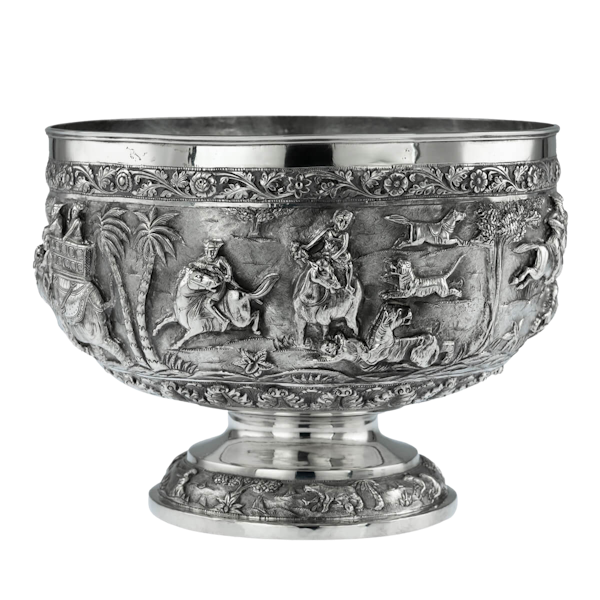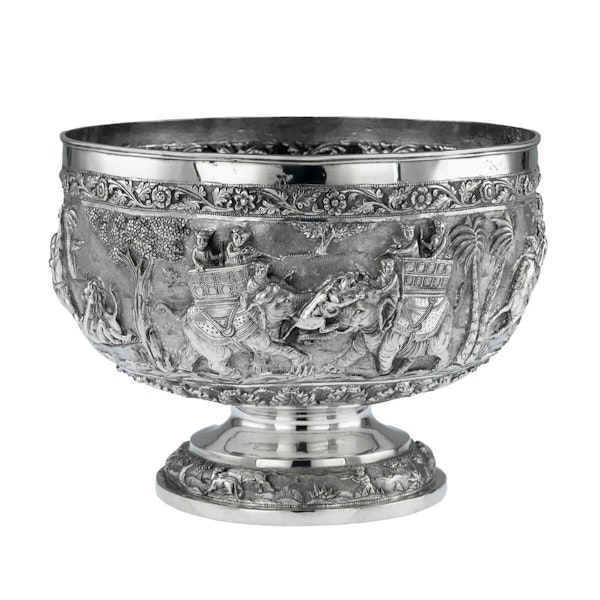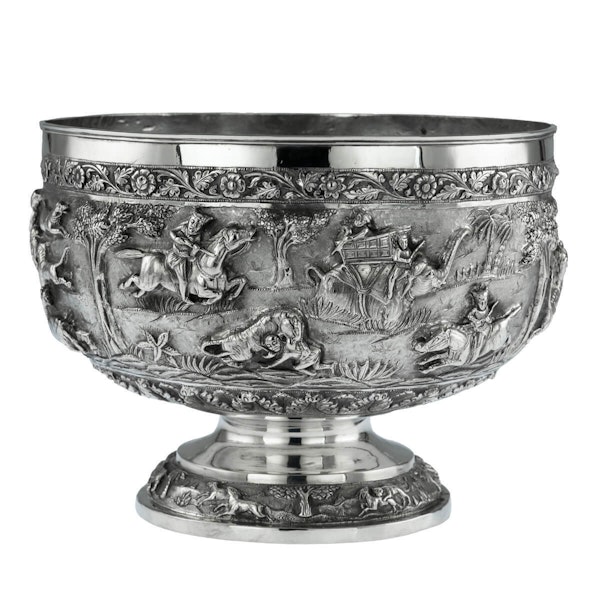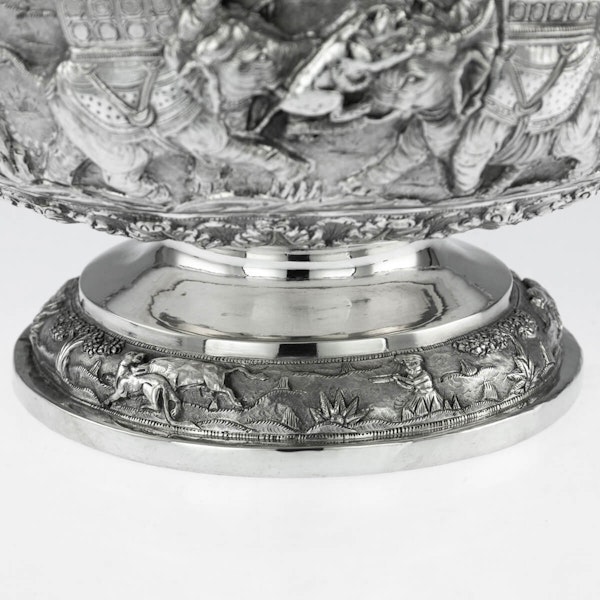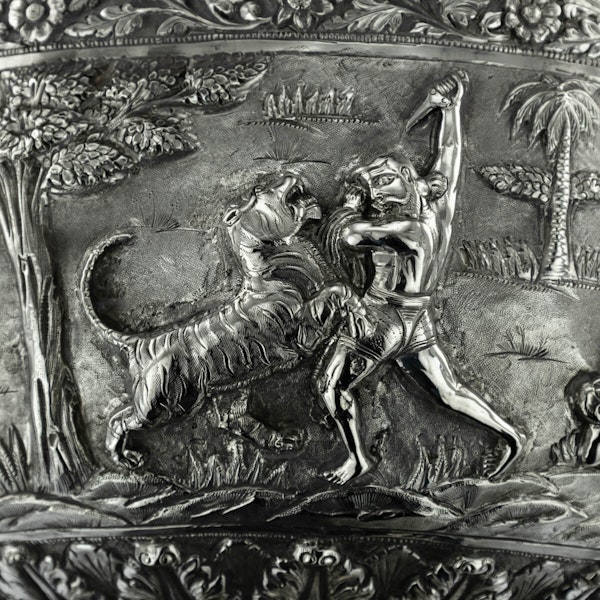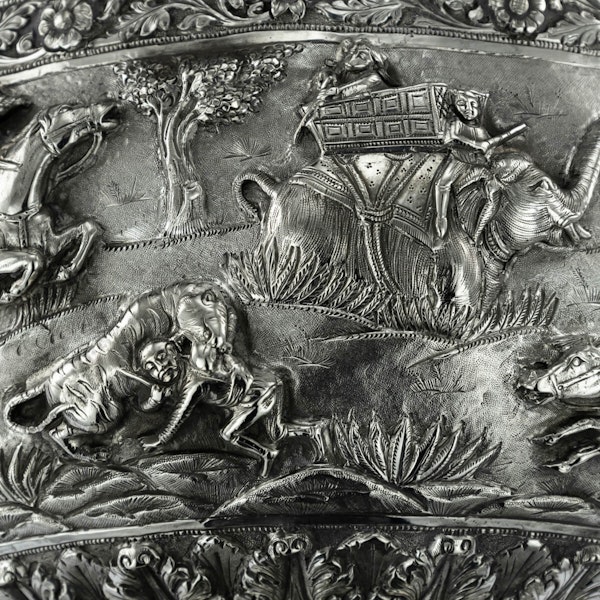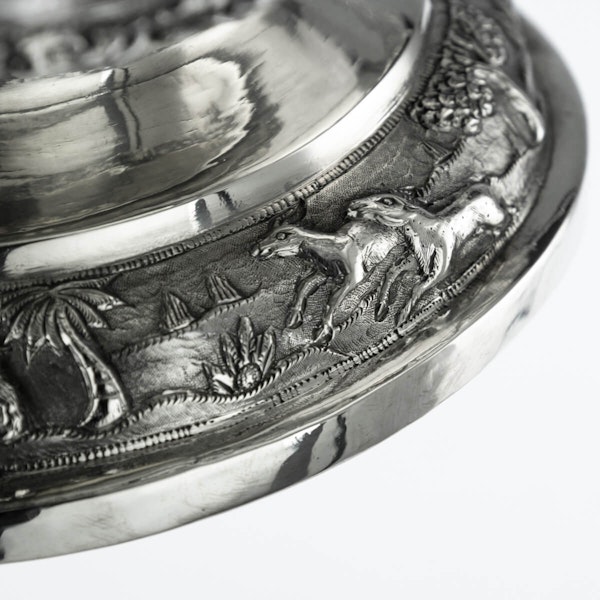Antique Indian Silver Pedestal Rose Bowl, Lucknow, India - 1876 to 1910
Antique Indian Silver Pedestal Rose Bowl, Lucknow, India - 1876 to 1910
£3,500.00
Description
This antique Indian silver pedestal rose bowl was made in Lucknow, India. It has been ornamented using repousse and chased techniques. The bowl is supported by a short plain silver stem over a plain silver stepped and spreading foot with a repousse and chased border featuring a hunting scene. The scene features a landscape with undulating ground, knolls and grassy hummocks, shrubs and trees including a palm tree. Two deer appear to be fleeing from a lion behind them which is now being attacked by a wild boar. A hunter with a rifle is approaching the boar and lion with his gun aimed and ready to fire. To the body of the bowl, a deep and finely cut acanthus border surrounds the base with a scrolling floral and foliate border just below the rim. Between them, a deep principal border depicts scenes from a tiger hunt but something more subversive, or at best, satirical, appears once you examine the scenes more closely.
The imagery has undoubtedly been inspired by the four month tour of India in 1875-6 by Prince Albert Edward, eldest son of Queen Victoria, the future King Edward VII, whilst Prince of Wales. He was a fanatical, almost obsessive hunter, who committed absolute carnage whilst on his visit to India, particularly during his two week tiger hunt in the Terai, an area of flatland in Nepal in February 1876.
Accompanied by the Prime Minister of Nepal, Maharajah Jung Bahadur, another legendary hunter, the Prince hunted relentlessly. Mounted on elephants, they bagged pheasants, deer, bears, wild pigs and countless tigers. One day, seven hundred elephants were employed in beating the jungle. They crossed the river in a single file and a couple of hours later they came across some tigers in a gully, which they encircled with elephants. One of the tigers, seeking escape, attacked the Prince’s elephant. Although shaken, he quickly turned around in the howdah and shot the tiger dead. An artist’s impressions of the scene, applauding the Prince’s quick actions and sharp shooting and entitled ‘The Critical Moment’ was widely distributed. The scene to the bowl with the two elephants and their passengers, undoubtedly references that famous encounter.
However, when you look at the people in the howdahs on the bowl, they all appear to be in Indian dress, not European. Turn the bowl around and you come to a scene where a standing man is fighting a tiger. The man, in his underpants, appears European and it is obvious that the tiger has inflicted some injuries to his leg. He is the only figure with a beard and bears an uncanny resemblance to King Edward VII and also to his son, the future George V, both of whom sported beards. The man wields a knife as he battles with the tiger. Possibly the tiger represents Tipu Sultan, who the British called the Tiger of Mysore, but the tiger could also symbolise India’s struggle against British colonial power and the King Emperor.
Tipu was a renowned Moslem Sultan who kept tigers and used the tiger as his emblem. He was killed by the British at the Battle of Seringapatam on 4th May 1799. Tipu had tried to forge an alliance with other Indian rulers and with the French, to resist the East India Company and prevent it from conquering the South of India. Some Indians, then and now, view him as a freedom fighter. It would not be surprising if in Moslem Lucknow, which had its own bloody history with the British during the Indian Rebellion, enduring the long Siege of Lucknow in 1857, that people viewed Tipu as a heroic resistance figure. The date the bowl was made is unknown, but the style suggests it was made during the last quarter of the nineteenth century or the first few years of the twentieth century. It is also possible that it could have been made at the time the next Prince of Wales, Edward VIIs son and the future George V, also visited Lucknow.
The future King George V and his wife, the future Queen Mary, visited India whilst they were still the Prince and Princess of Wales. Their tour took place in 1905-06 and the royal couple visited Bangalore, Benares, Jaipur, Udaipur, Kaputhala, Bikanir, Delhi, Lucknow, Indore, Mandalay, Rangoon, Karapur, Madras, Gwalior, Agra, Calcutta and Lahore. Like his father before him, he also visited Lucknow, which was the second visit by a Prince of Wales and future King.
This royal tour was very well publicised and widely reported in British newspapers at home as well as in the Indian press and internationally. At the time, the British public’s interest in all aspects of India and Indian life was extremely high. Their interest had been fuelled by the magnificence, pomp, and sheer exoticism, of the Delhi Durbar of 1903, which had presented such a spectacle just two years earlier. The couple’s progression through India caught the imagination of the British public again and the demand for news and pictures was insatiable. Many articles and reports of their visit were published in the press and accompanied by photographs. There is also surviving film footage, which was probably intended as a newsreel for the picture houses. The first picture house in Britain had opened in 1896, about ten years earlier, with others rapidly following.
A silent black and white film in the archives of the British Film Institute, documents the visit of the Prince and Princess of Wales to Lucknow in 1905. It follows the Prince’s itinerary which included visits to the Legislative Council Chambers, his inspection of the March past of the 16th Lancers, visits to the Residency, the Kaiserbagh and the Imambara, where he witnessed the distribution of food to the poor in Victoria Gardens. There is footage of the Prince enjoying a game of polo and visiting the racecourse for the Lucknow Gymkhana. The prince rode in some of the horse races himself and was placed first in two races and second in his other two races.
During the tour, the Prince also indulged his love of hunting, shooting and fishing, which his Indian hosts accommodated. There is a photo of him standing next to a tiger he has shot outside Hyderabad. He and the Princess were photographed at various hunts and shooting parties and amongst the many surviving photos are pictures of the Prince and Princess riding elephants and of the Princess riding a camel.
| item details | |
|---|---|
| Origin | Asian |
| Period | 19th Century |
| Style | Other |
| Condition | Excellent |
| Dimensions | Height 19 cms; Width 26 cms |
| Diameter | Weight:1160 grammes |
Product REF: 10056
